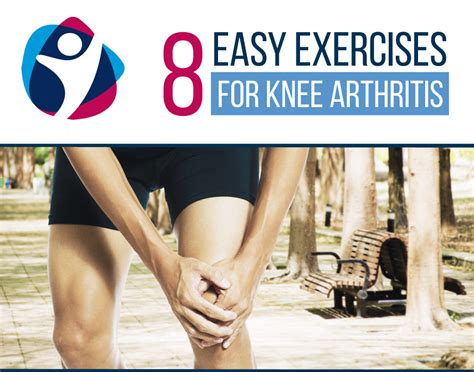Intro
Relieve arthritis knee pain with exercise. Discover 5 ways to reduce stiffness, improve mobility, and strengthen joints, promoting overall knee health and wellness through physical activity and gentle movements.
Regular exercise is a crucial component of managing arthritis, particularly for those suffering from arthritis in the knees. Exercise can help reduce pain, improve joint mobility, and strengthen the surrounding muscles, which can provide additional support to the knee joint. For individuals with arthritis knees, it's essential to choose exercises that are low-impact and do not put excessive stress on the knee joint. Here are some benefits of exercising with arthritis knees and ways to get started.
Exercise is beneficial for arthritis knees as it helps maintain joint mobility, reduces stiffness, and improves overall function. Moreover, regular physical activity can help with weight management, which is crucial for reducing the pressure on the knee joint. Excess weight can exacerbate arthritis symptoms, so engaging in exercises that promote weight loss can be particularly beneficial. It's also important to note that while exercise is beneficial, it's crucial to listen to your body and not overdo it, as excessive exercise can worsen arthritis symptoms.
Before starting any new exercise program, especially with a condition like arthritis, it's advisable to consult with a healthcare provider. They can provide guidance on the most appropriate exercises based on the severity of your arthritis and any other health considerations. Additionally, a healthcare provider or a physical therapist can help you develop a personalized exercise plan that meets your specific needs and abilities. This plan should include a mix of exercises that improve flexibility, strength, and cardiovascular health without putting too much strain on your knee joints.
Introduction to Exercise for Arthritis Knees

Understanding the importance of exercise for managing arthritis knees is the first step towards creating a healthier, more mobile you. Exercise not only helps in reducing the symptoms of arthritis but also improves overall health and well-being. It's essential to approach exercise with a mindset that prioritizes gentle, gradual progression, especially when dealing with a sensitive condition like arthritis. This means starting with low-impact activities and gradually increasing intensity and duration as your body allows.
Benefits of Exercise for Arthritis Knees
The benefits of exercise for individuals with arthritis knees are multifaceted. Exercise can help reduce pain and stiffness, improve joint mobility, and enhance the quality of life. Regular physical activity also supports bone health, which is particularly important for individuals with arthritis, as they may be at a higher risk for osteoporosis. Furthermore, exercise can help manage other health conditions that often co-occur with arthritis, such as diabetes and heart disease.Low-Impact Exercises for Arthritis Knees

Low-impact exercises are ideal for individuals with arthritis knees. These exercises are designed to minimize stress on the joints while still providing an effective workout. Examples of low-impact exercises include walking, swimming, cycling, and using an elliptical trainer. These activities can help improve cardiovascular health, strengthen muscles, and increase flexibility without putting excessive strain on the knee joints.
Walking as a Form of Exercise
Walking is one of the most accessible and beneficial exercises for individuals with arthritis knees. It's a low-impact activity that can be done almost anywhere and requires minimal equipment. Walking can help improve cardiovascular health, strengthen the muscles around the knee, and increase flexibility. It's essential to start slowly, perhaps with short walks, and gradually increase the distance and duration as your body becomes more comfortable with the activity.Strengthening Exercises for Arthritis Knees

Strengthening the muscles around the knee is crucial for providing support to the joint and reducing the risk of further injury. Exercises that strengthen the quadriceps and hamstring muscles are particularly beneficial. These can include straight leg raises, leg presses, and wall squats. It's essential to perform these exercises gently and within a comfortable range of motion to avoid exacerbating arthritis symptoms.
Flexibility and Stretching Exercises
Flexibility and stretching exercises are also vital for individuals with arthritis knees. These exercises can help improve range of motion, reduce stiffness, and alleviate pain. Examples include knee bends, straight leg stretches, and hamstring stretches. Like strengthening exercises, it's crucial to perform these stretches gently and within a comfortable range to avoid causing further strain on the knee joint.Managing Arthritis Knees Through Lifestyle Changes

In addition to exercise, lifestyle changes can play a significant role in managing arthritis knees. Maintaining a healthy weight is crucial, as excess weight can put additional strain on the knee joints. A balanced diet that is rich in fruits, vegetables, and whole grains can help reduce inflammation and promote overall health. Avoiding smoking and limiting alcohol consumption can also contribute to better management of arthritis symptoms.
Dietary Considerations for Arthritis Knees
Dietary considerations are an often-overlooked aspect of managing arthritis knees. Certain foods can help reduce inflammation and promote joint health, while others may exacerbate symptoms. Foods high in omega-3 fatty acids, such as salmon and walnuts, are known for their anti-inflammatory properties. Conversely, processed foods and those high in sugar can increase inflammation and should be consumed in moderation.Creating a Personalized Exercise Plan

Creating a personalized exercise plan is key to successfully managing arthritis knees through physical activity. This plan should be tailored to your specific needs, abilities, and health status. Working with a healthcare provider or a physical therapist can help you develop a plan that includes a mix of low-impact exercises, strengthening activities, and flexibility stretches. It's also important to listen to your body and adjust the plan as needed to avoid overexertion or exacerbating arthritis symptoms.
Monitoring Progress and Adjusting the Plan
Monitoring progress and being willing to adjust your exercise plan as needed is crucial. Keep a journal or log of your activities, noting any changes in your symptoms, mobility, or overall feeling of well-being. This information can be invaluable in identifying what works best for you and making necessary adjustments to your exercise routine. Regular check-ins with your healthcare provider can also provide insights into how your exercise plan is impacting your arthritis and guide any future modifications.Conclusion and Next Steps

In conclusion, exercise plays a vital role in managing arthritis knees. By incorporating low-impact exercises, strengthening activities, and flexibility stretches into your daily routine, you can reduce pain, improve mobility, and enhance your overall quality of life. Remember, it's essential to approach exercise gently and gradually, especially when dealing with a sensitive condition like arthritis. With patience, persistence, and the right guidance, you can develop an exercise plan that helps you manage your arthritis knees effectively.
If you're looking to start your journey towards a healthier, more mobile you, consider reaching out to a healthcare provider or a physical therapist to develop a personalized exercise plan. Remember to stay positive, listen to your body, and celebrate your small victories along the way. With the right mindset and support, you can overcome the challenges of arthritis knees and live a more active, fulfilling life.
What are the best exercises for arthritis knees?
+The best exercises for arthritis knees include low-impact activities such as walking, swimming, cycling, and using an elliptical trainer. Strengthening exercises like straight leg raises and wall squats can also be beneficial.
How often should I exercise with arthritis knees?
+The frequency of exercise with arthritis knees should be based on your individual health status and comfort level. Generally, aiming for at least 30 minutes of moderate-intensity exercise per day is recommended, but it's crucial to start slowly and increase duration and intensity as your body allows.
Can exercise worsen arthritis knees?
+While exercise is beneficial for managing arthritis knees, overexertion or engaging in high-impact activities can worsen symptoms. It's essential to listen to your body, start slowly, and avoid activities that cause significant pain or discomfort.
We hope this comprehensive guide to exercising with arthritis knees has provided you with valuable insights and practical tips to manage your condition effectively. Remember, every small step towards a healthier lifestyle counts, and with the right approach, you can reduce your symptoms and improve your overall well-being. If you have any questions or would like to share your experiences with exercising and arthritis, please don't hesitate to comment below. Your feedback and stories can inspire and help others who are facing similar challenges.
